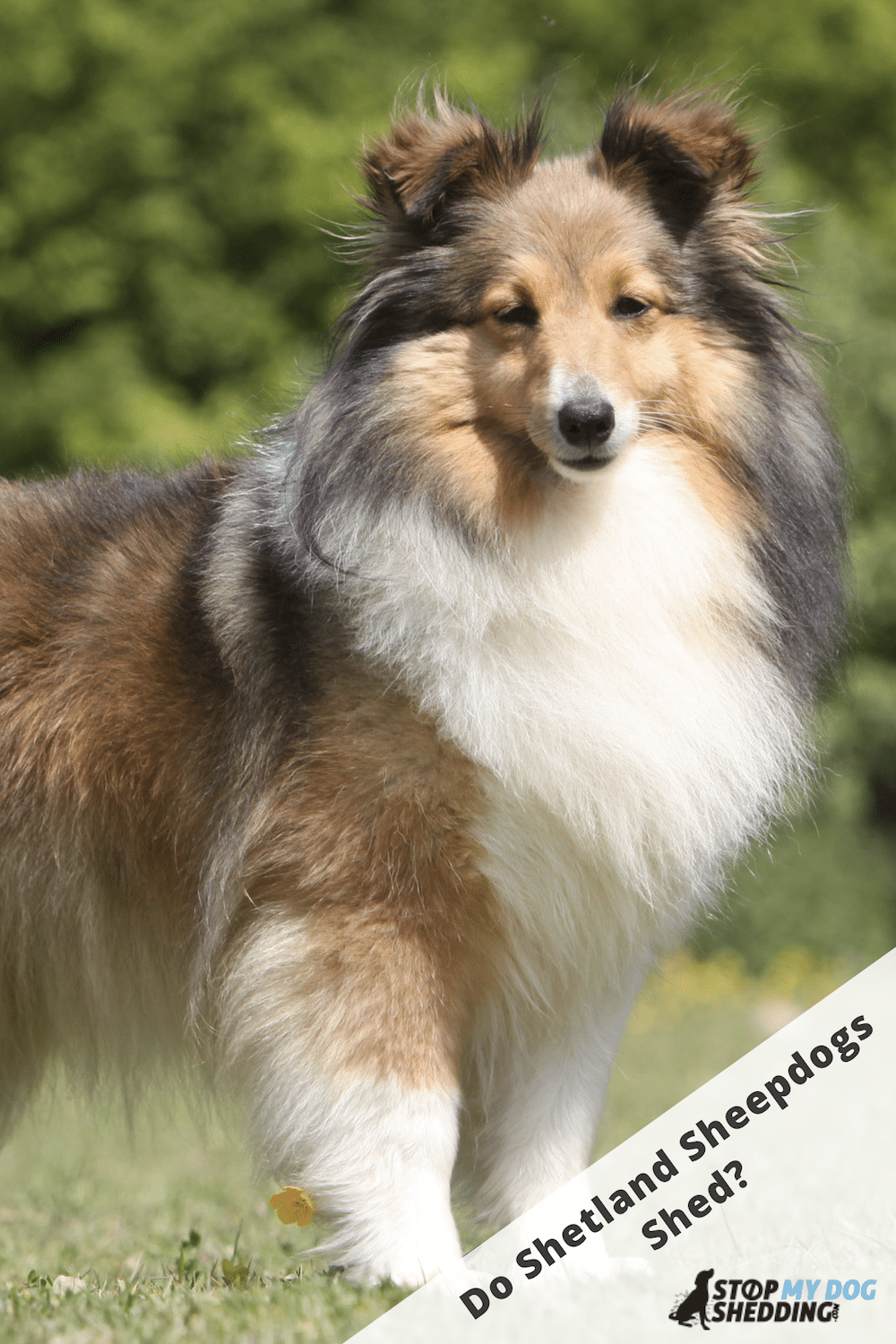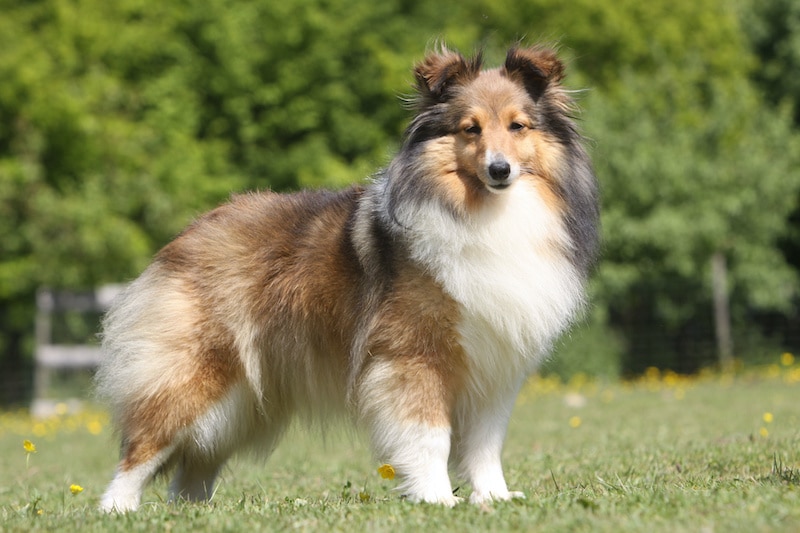Shetland Sheepdogs are small herding dogs that originate from the Shetland Islands where, according to the AKC, they were developed to herd sheep and ponies for farmers. They’re not just highly intelligent, capable working dogs though, they’re also popular companions that are known for their energetic and playful nature.
They do shed though – a lot.
Shelties have long, thick double coats that shed heavily throughout most of the year and even more during seasons like spring and fall. So they’re not ideal for those wanting a low molting, or hypoallergenic, dog breed.
The good news is that getting the shedding under control isn’t very difficult. It mostly comes down to proper nutrition and regular brushing. So in this post, we’ll take a look at how much fur you should expect to see around the home, as well as how to manage it properly.
Recommended: Go here to see our top-rated dog hair blow dryers
Shetland Sheepdog Shedding
Shelties are a high shedding breed.
They’re probably not as heavy shedding as breeds like the German Shepherd or Newfoundland Dog. Mostly because Shelties are quite a bit smaller and therefore don’t have as much fur to lose as larger dogs. But at the same time, they still shed a lot.
Another important thing to understand is that, if you have pet allergies, the Shetland Sheepdog is probably not ideal. And this is because their coat produces lots of dander (one of the main causes of pet allergies), and since they shed so heavily, they tend to spread this dander right throughout the home.
So, to sum it up, if you’re looking for a low shedding dog, or one that is considered to be hypoallergenic, the Sheltie may not be for you. And to be honest, it’s a similar story among most herding type dogs.
For example, the Collie is the Shelties cousin and he sheds heavily, both Cardigan and Pembroke Welsh Corgis molt lots, and so does the Belgian Sheepdog of which Shelties bare a resemblance.
There are some low shedding herding dogs out there though, such as the Spanish Water Dog. And there are plenty of low shedding dogs outside of the herding group, so if you’re not fussed about the herding aspect, you’ve got lots of options. It’s really just a matter of looking for the breeds that interest you and researching whether or not they’re likely to fill your home with fur.
Why do they shed so much?
Almost all dogs shed at least some fur, so unless you get a completely hairless breed, you should expect to see some hair floating around. Of course, it does depend on the individual breed as to how much they molt and how noticeable the shedding will be.
For example, some dogs:
- Have a rapid hair growth cycle, which basically means their fur grows, dies, falls out and is replaced at a much more rapid pace than some dogs, leading to higher shedding.
- Have a double coat, which means they have two layers of fur instead of just one (an outer coat and an undercoat). And so when these dogs shed, the volume of hair is amplified.
- Have longer fur than others. Which doesn’t dictate how much the molt, but longer hair tends to be more noticeable when it falls out than shorter hair.
Shelties tick all of the above boxes (rapid hair growth cycle, double coat, and their fur is long). So, even if your Sheltie is in great shape, and you’re doing all the right things, it’s normal to notice some fur around the home. There’s simply no getting around it.
That said, sometimes shedding can be the result of things like poor health, suboptimal diet, or things like fleas, hormonal imbalances or allergies for example. So if you have any concerns at all, it might be worth contacting a veterinarian.
Recommended: Go here to see our top-rated dog hair blow dryers
Are Shelties Difficult to Groom?
Shelties are not difficult to groom, but they do need to be brushed at least two-to-three times a week. And the reason for this is mostly because of how long and thick their coat is.
Shetland Sheepdogs have a double coat consisting of a long, thick, harsh and straight outer coat that comes in a variety of colors. But normally some combination of white, black, sable, tan and blue merle. And their undercoat is short, dense and furry.
This type of coat isn’t necessarily “difficult” to brush or otherwise maintain, but it is profuse and therefore takes longer to brush than a short-coated dog. For the same reason, it’s also prone to mats and knots, especially if your Sheltie goes outside a lot. So these will need to be brushed out on a regular basis.
And since he sheds so much, you are naturally going to need to brush him more often during shedding season, which normally happens a couple times per year for about two-to-three weeks at a time.
What sort of brush should you use?
There is no “best” single brush to use that will magically remove all of the hair. But some are more suitable than others. For instance, the slicker brush is a great brush for dogs with longer hair, like the Sheltie, and it’s one I personally like to use. You can also use a metal comb and pin brush for general coat maintenance and to help you work out the mats.
When it comes to shedding season, however, it’s hard to go past a shedding tool or undercoat rake. These types of brushes work well to remove the loose hair from your dog’s outer coat and undercoat, and in less time than it takes with a regular brush. If you want to learn more about the different types of dog brushes, check out this guide.
Can you shave or clip your Sheltie?
Some think you need to cut the coat of a dog with a long, thick coat to make them cooler. But this is not the case. Their coat insulates them in both cold and hot weather, and helps protect them from things like sunburn and windburn. So, unless your vet specifically recommends doing so, you should never cut your Shelties coat right down to the skin.
However, trimming your Shelties coat in some areas where it’s growing quite long is not uncommon and, as long as you don’t cut too much off, should be fine.
What about bathing and other grooming needs? Shelties don’t need to be bathed very often, they’re a pretty rugged dog. So other than brushing and the occasional bath, it really comes down to things like nail trimming and cleaning their ears and teeth, as with most dogs.
Recommended: Go here to see our top-rated dog hair blow dryers
How to Reduce Excessive Shedding
There’s no way to completely stop the shedding. If you adopt a Shetland Sheepdog, know that they are going to drop some hair around the home. You’ll find it on your floors, furniture, upholstery, and clothing. Basically anywhere they wander.
However, you can minimize excessive shedding and manage the situation so that you don’t have to spend as much time cleaning up loose dog hair. And while there are a number of ways to do this, it managing the shedding is basically a three phase approach:
- Diet: The most fundamental step in reducing shedding is to make sure your dog is as healthy as possible. And one of the simplest ways to do this is to ensure he’s eating a healthy, balanced diet made up of high quality dog food. So it’s worth speaking with your vet about selecting the right food for your dog, as this can make a big difference.
- Grooming: Brushing not only helps remove the dead fur from his coat before it falls out, but it also helps to improve the condition of his coat. Because when you brush you massaging his skin and spread his skin oils. Also, bathing him with a good quality dog shampoo during shedding season can help remove a lot of old fur. Just don’t overdo it as over bathing can dry out his coat and lead to even more shedding.
- Vacuuming: Once you’ve tackled molting through proper nutrition and grooming, vacuuming is the best way to help keep your home free of dog fur. And while not many people enjoy this task, there are some vacuums that can make your life easier. And the more consistent you are with the first two methods, the less time you’ll likely need to spend on this one.
Recommended: Go here to see our top-rated dog hair blow dryers
Bottom Line
Shelties are adorable, rugged, intelligent dogs that make great workers as well as companions. They do shed though, so they’re not the best choice for people who can’t stand seeing fur around the home, or for those who want a non-allergenic dog.
The good news is that, while you can’t completely stop the molting, you can effectively manage it and as a result, significantly reduce how much fur gathers around the home.
Read next: Do Miniature American Shepherds Shed?













Please note: By submitting a comment using the above comment form, you confirm that you agree with the storage and handling of your data by this site as detailed in our Privacy Policy.